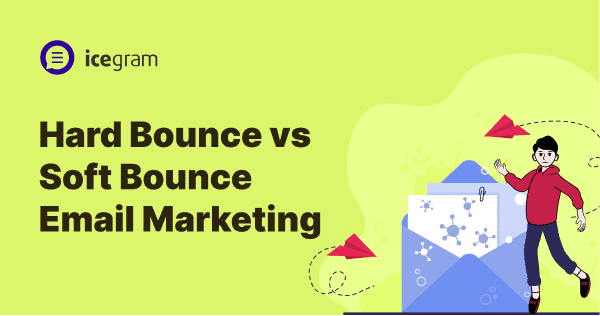Growing an email list with genuine subscribers is difficult.
Yet, when you send out email campaigns to them, you encounter a KPI called bounce rate.
So, what is this bounce rate in email marketing? What is hard bounce vs soft bounce email marketing? How to reduce your bounce rate?
Let’s dive into it.
What is bounced email?
When an email is not delivered to an email server, it’s a bounced email.
We all want our emails to reach our subscribers and nudge them to take an action after reading them. Be it a newsletter, blog post notification, discount offers, or solution for their query.
But still, a few emails do not reach the customer mailbox and are treated as a bounce.
Hard bounce vs soft bounce email marketing
All those bounces in email marketing are categorized into two types:
- Hard bounces
- Soft bounces
What is a hard bounce email?
A hard bounce is a permanent bounce, meaning the email won’t reach your subscriber. Hard bounces are a major problem as they hurt your email deliverability rate and sender reputation.
Hard bounce reasons:
- Invalid recipient email address (may not exist or a typo like gmali.com)
- The recipient’s email server has completely blocked delivery
- De-activated email address (when someone leaves a company)
What is a soft bounce email?
A soft bounce is a temporary bounce, meaning the email can be sent again to the subscriber if your current message delivery was unsuccessful.
Soft bounce reasons:
- The recipient’s mailbox is full
- Inactive mailbox
- Your emails are marked as spam
- The mailbox is not configured correctly
- Too large email
- Malicious content
- Email does not meet the recipient server’s policies
- The email account has been temporarily suspended
- Errors at the receiving mail server
Retry sending the email a few times as it is a soft bounce. If it still fails to deliver, consider it a hard bounce and remove that subscriber from your list.
If you are using WordPress, you can use the free plugin Icegram Express which will reveal whether your emails are hard bounces or soft bounces.
The plugin is active on 100000+ sites and allows you to send unlimited emails for free (using third-party services).
15 best ways to reduce your hard and soft email bounce rate
How much you try hard to achieve a 100% email deliverability rate, the bounce rate is unavoidable.
However, you can drastically reduce your email bounce rate by following these simple ways:
- Use an email verification service to check the validity of email addresses before sending out an email, reducing the chances of a bounced email.
- Authenticating your domain will help lower your email bounce rate.
- Use double opt-in and offer incentives. Encourage recipients to confirm their email addresses by offering incentives or exclusive content. This will build up a more engaged email list.
- Personalize emails by including the recipient’s name and relevant information about them in the email.
- Use short email subjects which match your email content.
- Avoid spammy language in your emails.
- Do not use large images or too many fancy elements that increase your email size.
- Clean up your list regularly to weed out invalid or outdated email addresses, and remove them to keep your email list up to date.
- Send a re-engagement email to users who haven’t opened an email for a long time. This is to find out whether they’re still interested in receiving emails from you.
- Avoid sending emails from a free service. Sending emails from Gmail or other free services may look unprofessional and subscribers may lose out on your brand connection. These services often don’t pass the DMARC policy, shooting up your hard bounces.
- Send emails consistently to keep subscribers engaged. If new subscribers sign up and then don’t hear from you for months, they may forget about you and may mark your emails as spam.
- A/B testing emails will give you insights into what is resonating with your readers. Monitor your email bounce rates, open rates, click rates and subscribers who have marked you as spam.
- Allow users to update their email address from their Account or during the checkout process.
- Don’t buy email lists, build your own.
- Include a visible unsubscribe link in all emails. Allow users to opt out if they wish to.
Final words
An email bounce rate under 2% is desirable. A lower value is even better but a higher value is a sign of worry.
So better keep your list healthy and clean to avoid the bounces. Create content that resonates with your readers.
That’s what I call email marketing done right.

